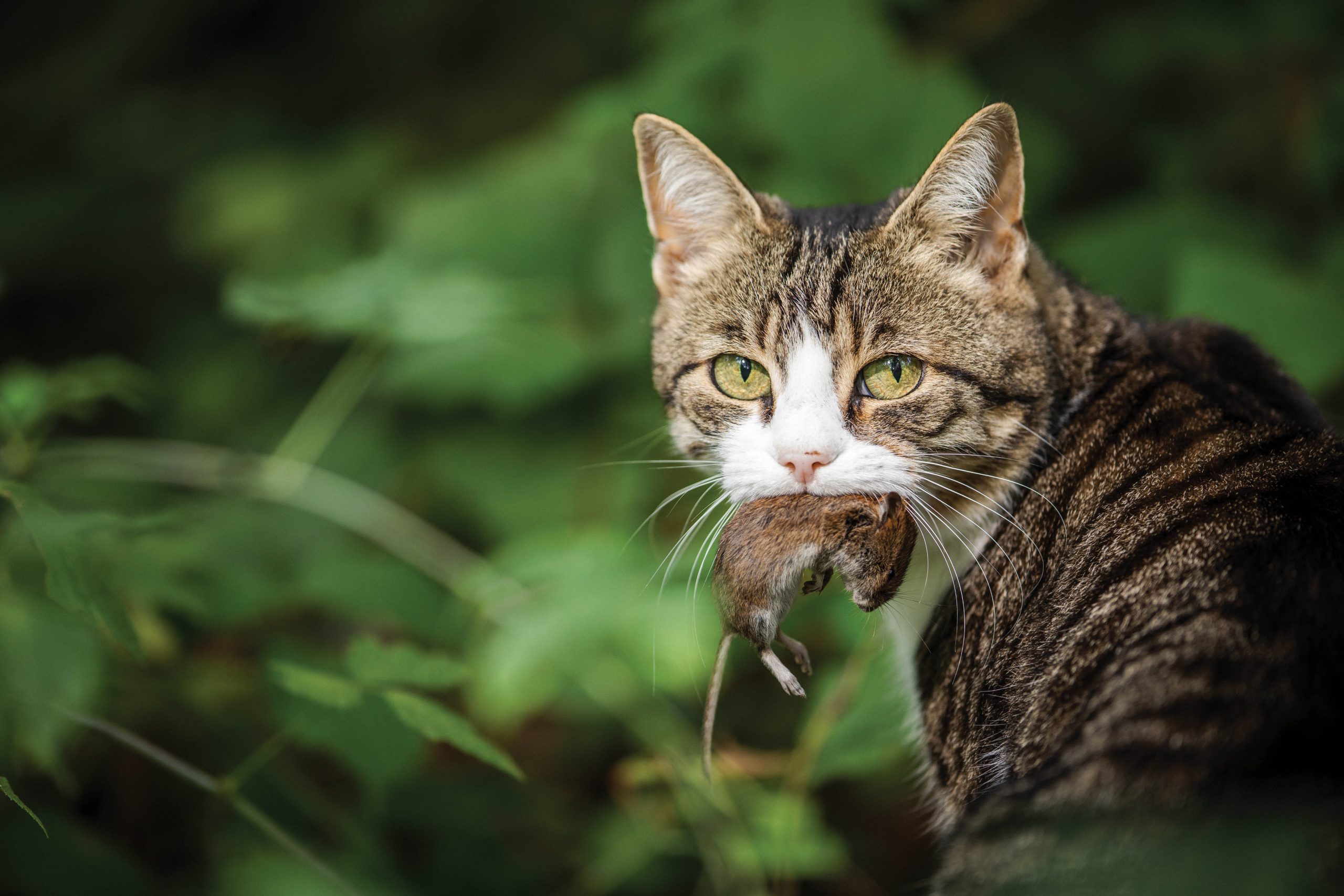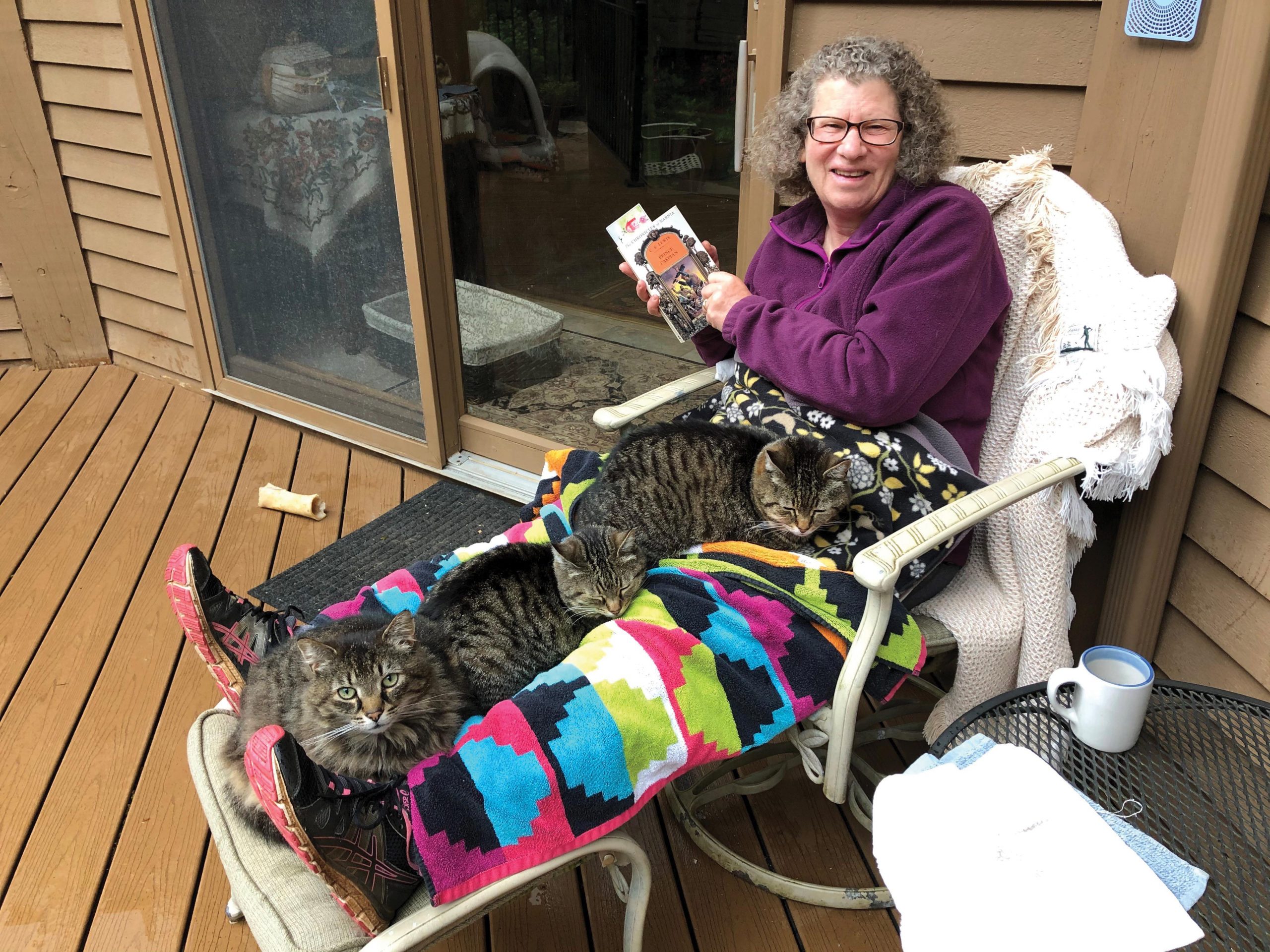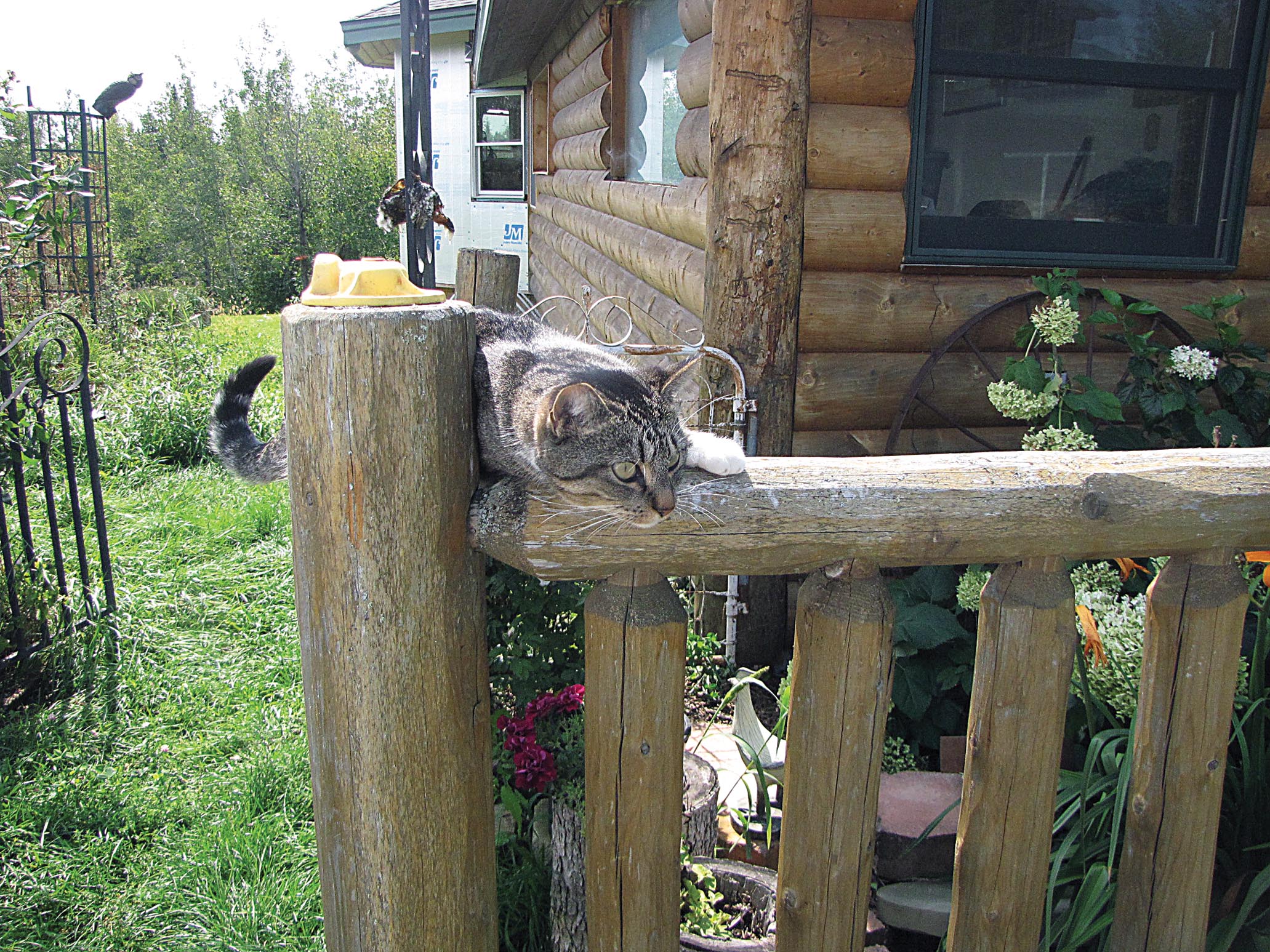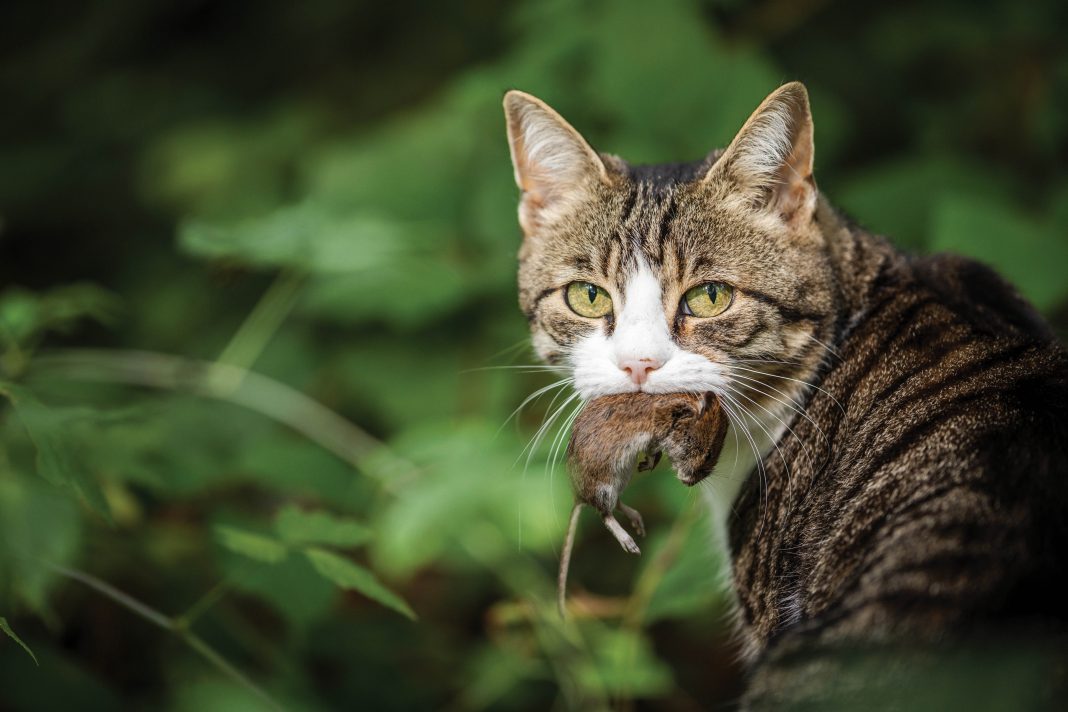By Jackie Clay-Atkinson
We have had at least one cat in our home ever since I was a young child. So it’s no wonder we truly value our feline friends. Not only do they provide entertainment (much more interesting than television), comfort, and companionship, but also help keep down the vermin around the homestead.
When Mom and Dad came to live with us here in Northern Minnesota, they also brought their three remaining old cats, Mimi, Texas Joe, and Monte. As the years passed, so did Mimi and Texas Joe, dying from old age. But Monte still hung in there. And boy did he hunt! First thing every morning we’d turn him out so he could hunt. He often came to the door with a fat mouse, ground squirrel, or vole. But when he finally died quietly (after a morning’s hunt), Will found his “trophy room” up in the hayloft. There was a pile of tails — a big pile! No wonder our gardens flourished so well.
It’s amazing how much damage voles, mice, ground squirrels, and chipmunks can do to your crops. They girdle fruit trees in the winter, eat into melons and squash, nibble the inside out of tomatoes, and dig up corn just after it germinates just to eat the seed below ground. And these critters are also very prolific, often having several big litters of young in one summer. Without a cat around we’d soon be run out by these little varmints.
When Monte passed away, we were left with no more cats. Soon after, Will and I stopped at our neighbor’s yard sale. We browsed a bit and the wife told us she had two kittens left to give away. Will asked to see the male. It was love at first sight and he tucked Mittens right into his shirt to stay warm.
That was years ago and Mittens is still with us. She hunts on and off all day and is a very effective hunter. “He” became a she when she went into her first heat. (Hey, we never looked!) So far, she has brought home countless mice, voles, ground squirrels, chipmunks, two big snowshoe rabbits she dragged down the driveway between her front legs like a lion, and seven weasels.
I’ve had several chickens and a whole pen of fancy pheasants killed by weasels so they’re on our hit list. They’re pretty tough customers too. That’s why we were very impressed when Mittens presented us with her first one.
Cats can be a terrific homestead help.

A good mouser won’t only get mice, but she’ll also hunt ground squirrels, voles, and chipmunks which can do a lot of damage to your crops.
Basic cat selection
We’ve found it best to get a kitten. When you raise a kitten, you can quickly correct any bad habits like getting on the counter, scratching furniture, or climbing the curtains. They quickly learn to use an indoor kitty litter box while some adult cats just won’t.
A squirt gun with water in it is a good correction for bad behavior. Keep one loaded and handy. Also provide the kitten something “good” to scratch and climb on such as a scratching post or kitty condo. If you provide an enclosed cat litter box, keep it clean of waste. The kitten will quickly learn where to go potty and have no mistakes. Mittens prefers to “go” outside and seldom uses her box.
If you get an older cat, do make sure you keep it inside for a few days until it gets the lay of the land. It needs to know where home is and come when called. (A special treat when it does is a huge help.) When you simply release a new adult cat to the barn or house, it often will freak out and run away.
Some say that female cats make the best mousers and that a female with kittens is the very best of all. Not really. Mittens is a female but she was spayed when she was six months old. I found out early on that when you have a female cat, she’ll soon have a litter of kittens. You quickly run out of people who want a cute kitten. Soon the leftover female kittens have a litter and you’re overrun with cats. Hungry cats are not good mousers; they’re often too weak and lethargic to chase pests.

Cats need and want attention as well as dogs. Ilene Duffy keeps warm with a nice cup of coffee and reading time with her three cats. From left are Omelette, Fluffy, and Pan.
A male cat can be a terrific mouser. Remember Monte? But please have him neutered. Males that are not neutered have the foul habit of spraying urine around the place marking “their property.” Put bluntly, it stinks. In addition, male cats will travel great distances looking for love. This puts them in danger of becoming coyote or fox bait, being run over by traffic, getting shot, or getting bitten up by a rival male. A neutered male stays home and is a much more delightful pet/hunter.
After choosing your kitten, please have it fixed at about 6-8 months of age. It is much cheaper to have a male cat fixed than a female as it is not as extensive a surgery. Mittens surprised us by being a female instead of a male but as soon as she had gone out of heat, we put her into a cat carrier and took her to our veterinarian to be fixed.
Please don’t get a “wild” feral barn cat thinking it will quickly put an end to all the mice and rats in your barn. This type of cat will often run away first thing, often dying a lingering death due to predators, traffic, or disease. Your children won’t be able to pet it in safety nor will you be able to catch it easily should it need a trip to the vet.
Basic cat care
It is essential that your cat be vaccinated against common cat diseases to protect it from contracting an illness. Talk to your veterinarian. Different diseases are more common in some areas of the country than others.
Feline distemper is rampant everywhere there are cats and is one disease nearly every veterinarian will recommend vaccinating against. I lost my very first homestead cat decades ago because I didn’t know enough to have her vaccinated. She contracted feline distemper which left her with matted eyes and nose. No matter what treatment the veterinarian prescribed, she died, leaving me devastated.
You should also vaccinate against rabies. This protects not only your cat, but you and your family from this horrible disease as well.
When your kitten is about eight weeks old you should worm it once a week for three weeks. Some worms, such as roundworms, pass from the mother’s body to the kitten’s. When wormed properly, both the adult worms and the larvae will be eliminated.
After that, kittens and adult cats should be wormed at least twice a year or every three months if they eat many rodents. Fleas from the rodents can cause the cat to develop tapeworms. (You can often see tapeworm segments clinging to an infected cat’s rectum or the fur around it, looking like grains of white rice.)

Mittens, our good homestead cat, is always on the lookout for varmints.
It’s best to talk to your veterinarian about a worming schedule. Like diseases, internal parasites vary in different parts of the country. The only way to effectively tell if your cat has worms or what kind of worms they are is to have a fresh stool sample examined under a microscope by your veterinarian.
In some parts of the country, fleas are prevalent. Mom used to have to dust her cats for fleas in Michigan often as they were very common. If your cat digs and scratches its body often, examine it carefully next to the skin. You’re looking for pin-head-sized flattish, brown, and quick moving insects. If you find them, dust the cat with a flea powder (we prefer pyrethrins as it is quite safe). Or use a topical spot treatment such as Frontline Plus for cats which kills fleas and ticks as well as killing future pests.
It is important, should your cat have fleas, to clean your house well. Fleas sometimes inhabit carpets, furniture, and even beds. They bite people too.
Like fleas, ticks are quite common in most parts of the country. We go over all our pets daily, checking for any ticks present. When finding them, we gently pull them and toss them into the toilet or wood stove. You can prevent ticks from clinging to your cat by treating early in the spring with a topical spot-type flea and tick product such as Frontline Plus for cats. We use this for Mittens as she hunts daily and we have dangerous deer ticks that can carry Lyme Disease. (I’ve been treated for Lyme Disease twice so far.) Cats seldom develop Lyme Disease but they can. It’s spread by ticks that cats can carry, not the cats themselves.
Ear mites are quite a common pest for cats. You might notice your cat scratching at its ears and shaking its head violently. On close inspection you’ll usually see brown foul-smelling matter inside the cat’s ears. You can easily treat this at home by first taking a ball of cotton, soaked in peroxide, and wiping off all the brown matter you can from as deep in the ear as your finger can reach. Then use a liquid cat ear mite treatment twice daily for a week. This nearly always effects a quick cure.
Should my cat be a house cat or a barn cat?
The more time a cat spends in the barn, the more opportunity it will have to see and kill varmints. But (and this is a big but) cats which live solely in the barn and around the homestead will be open to attack and death by larger predators. We have two family friends who, just last winter, lost their barn cats to attack by bobcats. We always keep our cats indoors during the night, safe from nocturnal predators. I’ve lost an indoor/outdoor cat to a Great Horned Owl myself. Other predators which will take a cat include foxes, coyotes, wolves, and large raptors.
This is why we make sure Mittens is in the house during the time these common hunters are out. She has her “curfew” of about half an hour before dark each day. In the summer she gets to spend a lot more time outside safely. In the winter she still hunts a lot but must be in at dark. I worry when she occasionally decides not to come in at night, even for her box of treats.
Many homestead cats are killed by vehicles as well. This is why when we first got Mittens and she got big enough to go outside, Will would chase her (gently) with our ATV. She quickly learned that when she heard a motor she should watch carefully and stay out of the way. If she is on a vehicle that starts up, she immediately jumps down and runs off. We always have the ATV, a tractor or two, farm machinery, and the UPS truck around the driveway. We do not like to bury a pet cat.
Should you decide your cat needs to be a barn cat, do make sure it has a comfortable spot in which to sleep. Even a cardboard box taped shut with cozy thick cushions or blankets inside will keep a cat warm, happy, and healthy even in a cold barn. Be sure it has a place it can escape larger predators such as a bobcat or coyote, perhaps a feed room with a small cat door.
Feeding your cat
As I’ve said, a hungry hunter is not a good hunter but you don’t want to let your cat get fat either. You don’t need to break the bank feeding your cat. There are all those fancy, canned, and raw foods available at most stores but they’re not necessary. We feed ours chiefly good quality dry food twice a day. Not only does this nourish Mittens, but it keeps her teeth bright, white, and shining. Cats fed chiefly canned cat food will develop layers of tartar on their teeth which usually leads to gum infections and abscessed teeth. These can cause the cat to die when left untreated. Feeding dry food keeps those hunter’s teeth healthy and ready for the hunt.
You can still give a little canned or raw food as a treat. When I’m cutting up venison to can, Mittens will sit right at my feet. She loves the raw tidbits I toss her.
Introducing a new cat to your dog
If you have a dog, it’s real important to carefully introduce a new cat safely. Dogs, especially large dogs, are used to guarding the homestead against predators. Sometimes they see a new cat as a type of predator and become protectively aggressive. Some dogs have even killed cats because of this.
You can hold a kitten firmly on your lap and have someone else hold the dog’s leash or collar when you first make the introduction. If the kitten freaks out or the dog acts aggressive, back off and calm both down. Scold the dog for his actions. Sometimes keeping the cat in a sturdy cat carrier allows the dog to examine the cat while, at the same time, keeping the cat safe and feeling sheltered. Unless the dog is very ho-hum about the new encounter, do not leave the two of them together in the same room alone. You may come back to a dead cat. Keep them apart unless very closely supervised for at least a week, making sure there is no aggressive behavior from the dog. (Some breeds are more prone to see the new cat as a varmint or prey than others.) Our dog, Spencer, is a black Labrador and just loves babies of any type: goats, pigs, calves … and kittens. He was a pushover when we brought Mittens home. They snuggled together and quickly became brother and sister. Spencer even let Mittens stand on his tongue and in his mouth so she could bite and box his nose.
I hope you have the best luck with your homestead cat. They can quickly melt your heart and keep your homestead safe from pesky critters.














